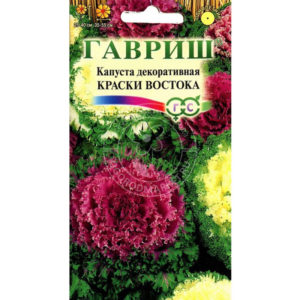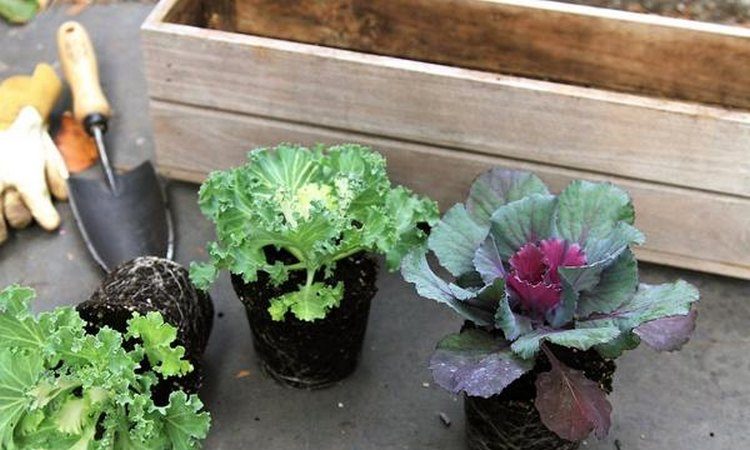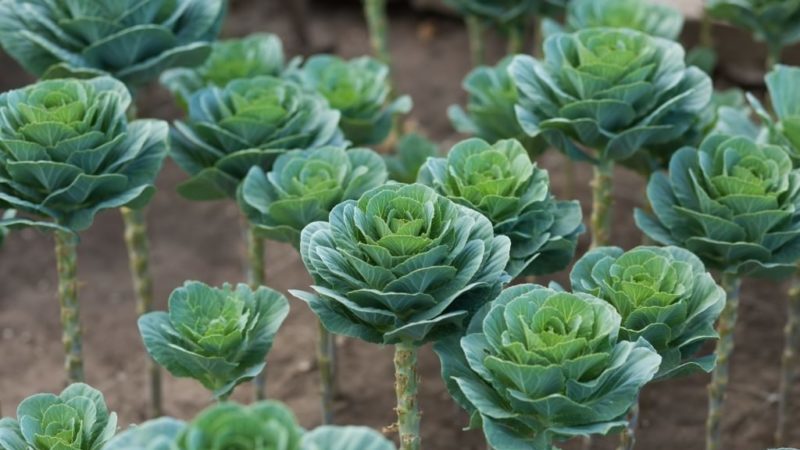Ornamental cabbage: photo, planting, cultivation and care
The spectacular variety of kale is called decorative. The agricultural technology of culture is simple, but it also has some secrets. So, not everyone knows that brassica is stored until the new season. Consider the features of planting ornamental cabbage and caring for it in the open field.
The content of the article
Growing seedlings of ornamental cabbage from seeds

Ornamental cabbage (brassica) is sown in early spring, in the south of Russia - immediately in open ground. For most areas, only seedlings are suitable. Seedlings are prepared 1.5 months before transferring to the garden bed (flower bed). Sowing dates for different climates:
- in the southern regions - late February - early March;
- for the middle lane, including the Moscow region - from mid-March;
- in Siberia, the Urals and the North-West of Russia - from the second decade of April.
Care and conditions for seed germination
The secret to healthy and strong seedlings: shade and warmth at the beginning of growing, light and cool at the end.
The traditional container is a rectangular container with a height of about 10 cm. It is convenient to move it, it is easy to care for the seedlings. As the plants develop, they dive into separate containers - plastic cassettes and peat cups 5–7 cm in diameter and 8–10 cm in height. Such a container takes up more space, but an intermediate transplant is not required for plants, the risk of injuring the roots is minimal. Holes are pierced in any container for water drainage.
The soil is taken loose, light, with neutral acidity (pH 6.2-7.0). Suitable formulations: garden soil, peat and river sand (1: 1: 1/2), or a bucket of turf and humus (1: 1) and 1 tbsp. ash, or ready-made universal mixture for vegetable seedlings.
Important! The day before sowing seeds are disinfected for 30-40 minutes in a 1% solution of potassium permanganate and allowed to dry at room temperature. The pelleted planting material does not require processing.
Step-by-step planting instructions:
- 1 cm of fine-grained drainage (brick chips, perlite) and soil are poured into the container. The surface is compacted and moistened with warm water. It is more convenient to use a spray bottle.
- In the container, grooves are made up to 5 mm deep, with a distance of 2.5-3 cm. Seeds are spread every 3 cm, the ground is leveled. 2 seeds are planted in cassettes and cups.
- The containers are covered with foil and placed in partial shade. Greenhouse temperature - + 18 ... + 20 ° C.
- Sprouts will appear in 3-5 days. On the first day after germination, the film is removed for 2-3 hours, and on the second day it is removed completely. Seedlings require long daylight hours (12-15 hours) and coolness: during the day - + 10 ... + 12 ° C, at night - + 6 ... + 8 ° C. A bright balcony or veranda will do. The lack of light is compensated by a phytolamp.
- A strong sprout is left in cassettes and cups, and a weak one is pinched. Water so that the soil is always moderately moist.
- After 10 days, the temperature is raised to + 13 ... + 16 ° C during the day and + 8 ... + 10 ° C at night.
- Top dressing is applied in the phase of the first leaf and a week after picking. Use ready-made complex fertilizer for vegetable seedlings or universal Fertika Lux.
- With the appearance of 2 true leaves, the seedlings from the container dive into separate pots with a diameter of about 7 cm. They deepen to the cotyledon leaves.
Ornamental cabbage is a cold-resistant crop. If you keep the seedlings in room heat, the sprouts will stretch out, thin out and weaken. At temperatures above + 18 ° C, healthy seedlings will not grow.
How to plant ornamental cabbage outdoors
From May to mid-June, brassica is transplanted into open ground. The timing depends on the weather and the condition of the seedlings:
- established air temperature - + 10 ° C;
- seedlings are 40–45 days old, each with 4-5 true leaves.
Soil preparation
Loamy and sandy loam soil is suitable for cabbage. It should be loose, neutral and moisture-permeable. The place is being prepared since autumn. The earth is dug to the depth of a bayonet, fertilized with humus or compost (1 bucket per 1 m²). For deoxidation add ash, dolomite flour or slaked lime (0.5 kg per 1 m²). In the spring, the land on the site is loosened and leveled.
Disembarkation algorithm

Seedlings are watered 6 hours before transfer to open ground.
The holes are staggered. For undersized plants - at a distance of 30–45 cm, for tall plants - 50–60 cm. The diameter of the planting hole is 2 times wider than the earthen ball of the seedling (10–15 cm), the depth is 15 cm. It is more convenient to calculate from the size of the seedling cup.
Brassica is planted by transshipment. The pot (glass) is carefully removed, the plant, along with an earthen lump, is placed in the hole. The hole is covered with earth to the lower leaves of the seedling, and the soil around the stem is compacted. Water abundantly, but so that the water is quickly absorbed and there are no puddles left.
Reference. Peat cups do not need to be removed - they quickly decompose in the soil and feed the roots.
To protect against insects, the beds are mulched with needles or powdered with wood ash, tobacco dust, a mixture of soda and allspice (2 tablespoons of pepper per 500 g of soda - a pinch around the stems).
Caring for ornamental cabbage
The main thing in caring for brassica is to water and make sure that pests do not spoil its lush outlet. After moistening, weeds are removed and tall hybrids are huddled to stimulate root growth and strengthen the stem.
Consider the features of growing crops and caring for photos.

Watering
Watering frequency depends on local climate and weather conditions. From excess moisture, the plant will begin to rot, and from a lack of moisture, the rosette will deform. Water the crop in the morning with warm water so that the soil is always moderately moist.
In the first week of growth in the open field, the seedlings are moistened daily, then - once a week. During the summer heat - 2 times a week, 5-8 liters of water are consumed for each bush.
If brassica is grown in decorative garden pots or pots with a volume of 10-15 liters, it is watered once every 2-3 days, and in the heat - daily.
Watering at the root alternate with sprinkling. Mulching helps to retain moisture, protects against dryness and weeds.
Top dressing
The first top dressing is 2 weeks after planting. For a quick set of green mass, any nitrogen fertilizer is applied once.
Important! It is not recommended to get carried away with feeding, two per season is enough. The plant will not die from an excess of nutrients, the rosette will be lush and green, but the decorative color will not appear.
3 weeks after the first fertilization, a complex nitrogen-free agent based on phosphorus, potassium and magnesium is applied.
Prevention of diseases and pests
The causes of diseases are the weather (frequent rains, abnormal heat), insect pests, but most often errors in agricultural technology and crop rotation: thickened plantings, waterlogging and watering with ice water. Because of this, root rot and powdery mildew appear, and insects breed during dry periods, with a lack of moisture.
Disease prevention measures:
- in the fall, clean the area from plant debris - pest eggs remain in them and pathogenic microflora develops;
- lime the soil before winter - cabbage is sick in an acidic environment;
- disinfect seeds before sowing;
- treat the soil with a fungicide (TMTD, iprodion) if the plants were sick last season.
How to prevent pest damage:
- For bedbugs, cruciferous flea beetles, cabbage flies, marigolds, dill, calendula, and basil are planted next to brassica. Wormwood branches are laid out between the rows.
- From caterpillars, slugs, aphids, plants and soil are powdered with a mixture of ash and ground pepper, mulched with needles, sprayed with water acidified with vinegar.
- Universal home remedy - tobacco dust infusion: 2 tbsp. tobacco dust is insisted in 5 liters of hot water for a day, filtered and 2 tbsp. l. liquid soap. Plants are sprayed every 2 weeks.
How to keep ornamental cabbage until spring
Brassica does not lose its decorative appearance for a long time. It winters calmly in the southern regions, but in regions with a cold climate it will not survive a frosty winter. In this case, there is a way to preserve the plant until the new season.
In the fall, before the first frost, the cabbage is dug up together with the root and the excess soil is shaken off. It does not need to be completely cleaned, but the ground must be dry. The root is wrapped in a plastic bag. The plant is suspended with a rosette down in a dark and cool room (basement, closet or on a cold veranda).
Winter storage conditions:
- temperature - + 1 ... -1 ° C;
- air humidity - 85–95%.
If stored properly, the leaves will not wilt.
Reference. Frozen plants are not dug up. They will rot quickly and are therefore not suitable for storage.
Reproduction of ornamental cabbage

Ornamental cabbage has a two-year life cycle. In the first year, the plant forms a rosette, from the second it blooms and gives seeds.
To get seed, cabbage is dug up in autumn and stored until spring. By the end of March, buds will hatch on the stem. The plant, together with an earthen lump, is placed in a pot of water and transferred to a bright and cool room.
In late April - early May, cabbage is planted in open ground. Dig a hole to the size of the roots, add humus (1/2 bucket) and watered abundantly (8-10 liters of water). The plant is buried to the level of the buds. In case of recurrent frosts, cover with spunbond.
Brassica will bloom by the end of summer. Fruit pods will appear after 20 days. The seeds are harvested a month later, before the pods open.
It is interesting:
Benefits and harms, features of the use of savoy cabbage
Kale cabbage - what kind of plant is it and what it looks like
Conclusion
Ornamental cabbage is called a long-liver of the garden - it does not lose its attractive appearance until mid-December. The culture is grown in seedlings. Key points of care are proper watering and pest control. In the fall, the plant is dug up, stored and planted the next season.